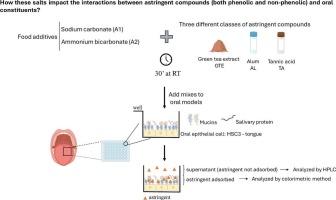食品添加剂(碳酸钠和碳酸氢铵)对涩味化合物与口腔细胞模型相互作用的影响
IF 9.8
1区 农林科学
Q1 CHEMISTRY, APPLIED
引用次数: 0
摘要
许多食品含有添加剂,如碳酸钠和碳酸氢铵,以确保安全,保持质量,或延长保质期。最近的研究表明,这些添加剂可能影响收敛化合物和口腔细胞之间的相互作用。使用舌上皮细胞模型,我们研究了这些盐如何影响涩味化合物(酚类和非酚类)和口腔成分之间的相互作用。这些盐降低了绿茶黄烷醇提取物(GTE)与唾液蛋白的相互作用,并改变了与单宁酸和明矾的相互作用。效果取决于具体的收敛化合物、盐和口服成分,离子强度起作用。GTE对黄烷醇的吸附减少可能是由于这些添加剂引起的氧化,这引起了人们对其使用的关注。然而,碳酸钠和碳酸氢铵可以改变收敛分子的相互作用,潜在地影响某些产品的收敛性。本文章由计算机程序翻译,如有差异,请以英文原文为准。

Impact of food additives (sodium carbonate and ammonium bicarbonate) on interactions between astringent compounds and an oral cell model
Many foods contain additives like sodium carbonate and ammonium bicarbonate to ensure safety, preserve quality, or extend shelf life. Recent studies suggest these additives may influence interactions between astringent compounds and oral cells. Using a tongue epithelium cell model, we investigated how these salts affect interactions between astringent compounds (phenolic and non-phenolic) and oral constituents. The salts reduced the interaction of green tea flavanol-rich extract (GTE) with salivary proteins and altered interactions with tannic acid and alum. The effects varied depending on the specific astringent compound, salt, and oral constituents, with ionic strength playing a role. The reduced adsorption of flavanols from GTE may be due to oxidation induced by these additives, raising concerns about their use. However, sodium carbonate and ammonium bicarbonate can modify astringent molecule interactions, potentially influencing the astringency of certain products.
求助全文
通过发布文献求助,成功后即可免费获取论文全文。
去求助
来源期刊

Food Chemistry
工程技术-食品科技
CiteScore
16.30
自引率
10.20%
发文量
3130
审稿时长
122 days
期刊介绍:
Food Chemistry publishes original research papers dealing with the advancement of the chemistry and biochemistry of foods or the analytical methods/ approach used. All papers should focus on the novelty of the research carried out.
 求助内容:
求助内容: 应助结果提醒方式:
应助结果提醒方式:


